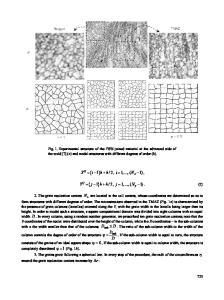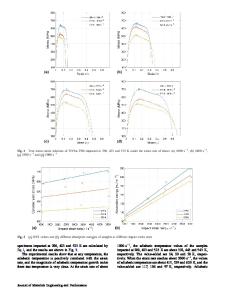Effect of Weld Characteristic on Mechanical Strength of Laser-Arc Hybrid-Welded Al-Mg-Si-Mn Aluminum Alloy
- PDF / 3,975,878 Bytes
- 12 Pages / 593.972 x 792 pts Page_size
- 62 Downloads / 420 Views
TION
PRECIPITATION-HARDENED Al-Mg-Si-Mn aluminum (Al) alloy (AA6082-T6) is a heat-treatable reinforced alloy. It has been widely used in a high-speed train vehicle structure for its preferable properties of low density, high specific strength, and favorable plasticity.[1] Since the assembling of the high-speed railway vehicle car-body depends on welding entirely, the rapid development of the high-speed rail network, especially in China, demands new welding techniques to obtain higher welding speed and better welding quality. Some modified MIG welding and friction stir welding (FSW) have been studied for this aim.[2,3] During MIG welding, bigger heat input easily coarsens or dissolves the Mg2Si’ phases or Mn-containing dispersoids in the weld, which significantly decreases the joint strength.[4] FSW also has shortcomings, such as geometrical constraints, low welding speed, root flaws due to the lack of tool penetration, and high force to react against the welding tool pressure load.[2] It makes the FSW of a thick-walled structure less efficient. Laser-arc hybrid welding (LAHW) is now one of the most promising types of fusion welding because it combines the advantages of both laser welding and arc welding, such as deeper penetration depth, faster
CHEN ZHANG, Lecturer, is with the School of Mechanical & Electrical Engineering, Wuhan Institute of Technology, Wuhan 430205, P.R. China, and also with the Wuhan National Laboratory for Optoelectronics, Huazhong University of Science and Technology, Wuhan 430074, P.R. China. MING GAO and XIAOYAN ZENG, Professors, and MING JIANG, Lecturer, are with the Wuhan National Laboratory for Optoelectronics, Huazhong University of Science and Technology. Contact e-mail: [email protected] Manuscript submitted November 7, 2015. METALLURGICAL AND MATERIALS TRANSACTIONS A
welding speed, and better welding quality. This new welding technique has garnered more and more attention in the past decade and has been successfully used in the manufacturing of steel structures, such as ship decks, car bodies, and oil pipelines.[5,6] Some studies have addressed Al alloys with a thickness of less than 5 mm. The results showed that compared with MIG welding, the LAHWed Al joints were 85 pct less thermal distortion, had a fine microstructure, and had 10–20 pct higher tensile properties.[7–13] However, no reports have been done on LAHWed Al joints with a thickness above 5 mm because LAHW of thick Al alloys faces more challenges. First, the suppression of weld porosity becomes more difficult, and the difficulty increases with the increase of the thickness. During LHAW or laser welding of Al alloys, the weld porosity is mainly caused by the collapse of unstable laser keyhole and hydrogen gas bubbles.[14,15] The deeper the laser keyhole, the unstable the laser keyhole, and the easier the formation of weld pores.[16] During LAHW, the arc pressure can accelerate the escape of the bubbles from the molten pool to the air by enlarging the molten pool and the driving force of melt flow, prolonging the solidification.[17,18
Data Loading...











